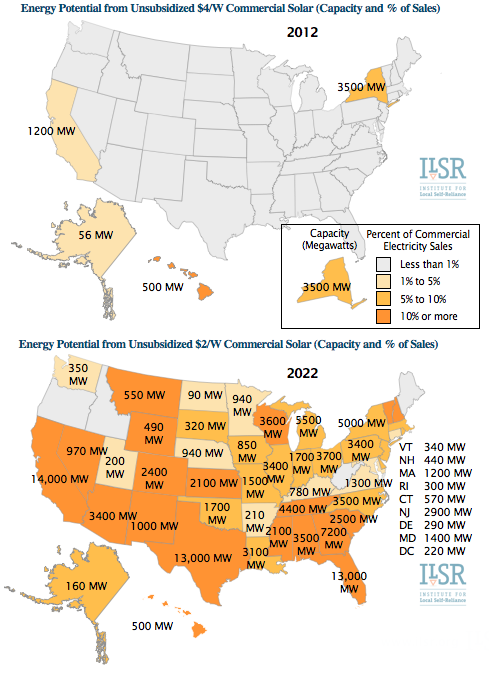Understanding Future Uses of Roofspace and Defining An Early Path to Profitable Roof Estate Investing
December 5th, 2012
Via The Institute for Local Self Reliance, an interesting look at the opportunity for rooftop generation in the years ahead:
The United States has over 4,000 megawatts (MW) of solar photovoltaics (PV) connected to the grid, with the pace of new installations accelerating as the price continues to fall. There has never been a better opportunity for Americans to generate their own electricity on-site nor such a challenge to the electricity system paradigm and for its policy makers and regulators. The greatest challenge is to prepare: although only 0.1% of electricity is generated by solar power in 2012; within a decade, 300,000 MW of unsubsidized solar power will be at parity with retail electricity prices in most of the United States and more than 35 million buildings may be generating their own solar electricity sufficient to power almost 10% of the country.
Solar parity begins in areas with strong sun and high electricity prices. In some places (like Hawaii) that has already occurred. In several parts of the country, e.g. southern California, New York, parity is just around the corner. Commercial solar represents a third of the total installed base for solar PV and it has grown faster and the price has fallen more rapidly (by nearly 30% in two years) than for residential solar. Meanwhile, retail electricity prices have risen by 3% per year in the past decade.
Until now, the solar energy boom has largely been driven by federal tax incentives and state-based incentives. But incentive policies will also need to change to accommodate the uneven geographic distribution of unsubsidized solar at price parity.
Furthermore, almost all attention on solar power has been focused on cost, but industry, utilities, and policy makers need to begin addressing significant non-cost barriers that will become prominent as parity arrives.
Key Findings
- Falling solar costs will result in 33,000 MW of unsubsidized commercial rooftop solar achieving price parity by 2016, enough to meet 2.7% of commercial electricity demand.
- Falling solar costs mean 122,000 MW of unsubsidized commercial rooftop solar will be at price parity by 2022, enough to meet 10% of commercial electricity demand.
- Although commercial solar is growing faster, unsubsidized residential solar has a significantly larger parity potential (190,000 MW by 2022, compared to 122,000 MW for commercial solar).
- Together, unsubsidized residential and commercial solar at price parity could provide 9% of total U.S. electricity by 2022.
- As the economic barrier shatters, other barriers to rooftop solar emerge: archaic utility rules (e.g. the 15% Rule), net metering caps, limits of local permitting offices, and a dearth of state virtual net metering policies.
Year-by-Year Solar Parity Potential
The following table shows the parity potential for residential and commercial solar power by year. For example, in 2016 when the installed cost of solar will approach $3 per Watt, there’s a potential to install 75,000 MW of residential solar and 33,000 MW of commercial solar in utility service territories at prices competitive with retail electricity.
Existing federal and state incentives expand and accelerate the parity opportunity, but also create pitfalls. The sudden reduction of the federal tax credit in 2016 could set back solar markets in several states by 5 to 6 years. But without incentive changes, the tax credit may over-reward producers in sunny states at the expense of those in states with nascent solar markets.
Policy makers need to replace a one-size-fits-all incentive program with one that can adapt to the rapidly falling cost of solar and variations in regional competitiveness (e.g. a CLEAN Contract). It will also be necessary to address unexpected barriers to solar that emerge as the cost issue fades away.
A Decade Spreads Solar Parity Far and Wide
The following maps illustrate the enormous potential for the spread of solar at retail price parity. An impressive 5.5 gigawatts of solar is already at price parity in 2012, rising to 122 gigawatts in 2022.
This entry was posted on Wednesday, December 5th, 2012 at 6:35 pm and is filed under Uncategorized. You can follow any responses to this entry through the RSS 2.0 feed. You can leave a response, or trackback from your own site.
Leave a Reply
You must be logged in to post a comment.
Educated at Yale University (Bachelor of Arts - History) and Harvard (Master in Public Policy - International Development), Monty Simus has held a lifelong interest in environmental and conservation issues, primarily as they relate to freshwater scarcity, renewable energy, and national park policy. Working from a water-scarce base in Las Vegas with his wife and son, he is the founder of Water Politics, an organization dedicated to the identification and analysis of geopolitical water issues arising from the world’s growing and vast water deficits, and is also a co-founder of SmartMarkets, an eco-preneurial venture that applies web 2.0 technology and online social networking innovations to motivate energy & water conservation. He previously worked for an independent power producer in Central Asia; co-authored an article appearing in the Summer 2010 issue of the Tulane Environmental Law Journal, titled: “The Water Ethic: The Inexorable Birth Of A Certain Alienable Right”; and authored an article appearing in the inaugural issue of Johns Hopkins University's Global Water Magazine in July 2010 titled: “H2Own: The Water Ethic and an Equitable Market for the Exchange of Individual Water Efficiency Credits.”

